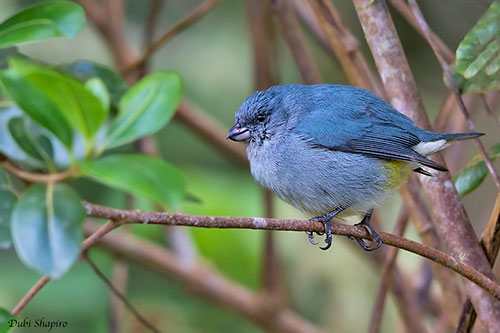
The adult female has olive back, rump and tail. On the upperwing, the flight-feathers are dark with green gloss. The outer primaries have yellow edges and the tertials are mostly olive-green.
Head and underparts are grey with slightly darker head. The throat is mostly whitish, belly and undertail-coverts are tinged buff, and flanks are washed olive.
The juvenile resembles female but it is slightly duller overall.
RANGE:
The Jamaican Euphonia is found only in Jamaica.
HABITAT:
The Jamaican Euphonia frequents open areas with trees, forests and borders, shrubby areas with trees, gardens and orchards. However, the species is usually most common in open secondary growths in hilly lowlands. It is visible from sea-level to 2,250 metres of elevation.
CALLS AND SONGS: SOUNDS BY XENO-CANTO
The Jamaican Euphonia gives a rapidly repeated “chur-chur-chur-chur-chur” sounding like a motor being started. This series may include a rising “chip” at the end, but this note is sometimes absent.
The song is a melodious, squeaky whistle. We can also hear various other sounds such as chuckling, mewing and other hard or squeaky notes.
BEHAVIOUR IN THE WILD:
The Jamaican Euphonia is mainly arboreal. It feeds primarily on fruits and berries, and the mistletoe berries form the main part of its diet. This plant depends heavily on this bird for its seed dispersal, because few other species consume these berries. But it also consumes fruits of Ficus, Cecropia and some others, young shoots, buds and flowers.
The Jamaican Euphonia forages sometimes in flocks in the canopy and usually high in trees. It is very active while foraging.
This species may roost in small groups, depending on the season.
It nests in a spherical structure well-hidden among the vegetation in tree.
This species is resident but some seasonal movements around the island are reported.
The flight is easy, agile and fast.
REPRODUCTION OF THIS SPECIES:
The breeding season takes place between February-March and May.
Both adults build a spherical nest, a domed structure with a side entrance. It is made with grass, stems and plant down. It is well-hidden in Spanish moss (Tillandsia) and bromeliads. It can be found at various heights in trees.
The female lays 3-4 white eggs with darker markings at the broad end.
PROTECTION / THREATS / STATUS:
The Jamaican Euphonia has restricted range in which it is common and widespread and the species occurs in numerous protected forests. When it forages in flocks, it may damage fruit crops.
The Jamaican Euphonia is not globally threatened and currently evaluated as Least Concern.
Fr: Organiste de la Jamaïque
Ang: Jamaican Euphonia
All: Gimpelorganist
Esp: Eufonia Jamaicana
Ita: Eufonia della Giamaica
Nd: Jamaicaanse Organist
Sd: jamaicaeufonia
Photographer:
Dubi Shapiro
Dubi Shapiro Photo Galleries & Dubi Shapiro's Pictures on IBC
Text by Nicole Bouglouan
Sources:
HANDBOOK OF THE BIRDS OF THE WORLD Vol 16 by Josep del Hoyo- Andrew Elliot-David Christie – Lynx Edicions – ISBN: 9788496553781
BIRDS OF THE WEST INDIES – by Herbert Raffaele, Kristin Williams et Tracy Pedersen – Helm – ISBN: 9780713649055
A Photographic Guide to the Birds of Jamaica De Ann Haynes-Sutton, Yves-Jacques Rey-Millet, Audrey Downer, Robert Sutton – Editeur: Bloomsbury Publishing, 2010 – ISBN: 1408133229, 9781408133224 – 336 pages
Neotropical Birds – Cornell Lab of Ornithology
Jamaican Euphonia
Euphonia jamaica
Passeriformes Order – Fringillidae Family
INTRODUCTION:
The Jamaican Euphonia is endemic to Jamaica where it occurs at all elevations in both wooded and open areas.
It feeds primarily on fruits from various plant species, but it also consumes buds and flowers. It nests in a spherical structure with side entrance placed in tree.
The Jamaican Euphonia is common and widespread and the species is not globally threatened.
The genus Euphonia has long regarded as tanagers, but following molecular-genetic studies, this genus was considered closest to Fringillidae in which it is classified today.
DESCRIPTION OF THE BIRD:
The Jamaican Euphonia is a small, compact blue-grey bird with short, thick bill.
The adult male is bluish-grey (mostly bluish in good light). There is a small yellow area at bend of wing, but rarely visible. On the upperwing, coverts and flight-feathers are dusky with bluish wash or gloss. The tail is similar.
Throat and underparts are grey, but slightly paler than upperparts. Centre of lower breast and belly is yellow, whereas undertail-coverts are buffy-yellow.
The short, stubby bill is pale blue-grey with black culmen, cutting edges and tip. The eyes are dark brown. Legs and feet are dark grey.
